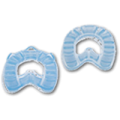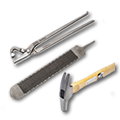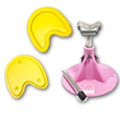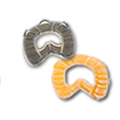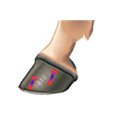Frequent Asked Questions and Answers at your Fingertips
Q: What type, and/or model of shoes should I use as I have not used TERRAFLEX™ shoes before?
A: Choosing the right type and/or model of the shoe depends on three (3) main facts: hoof health, the overall condition of your horse, and the tarmac you are riding on. Please click on the link for more info. https://bluepegasos.com/info
Q: What is the difference between the CCC and RCC models?
A: The CCC model is the standard shoe that has a flat hoof surface, and is fitted with side and toe clips that can be removed as wished. The RCC model is fitted with side clips (which can be removed if wished) and an improved breakover shoe, which also when fitted prevents the overstepping of the rear hooves.
Q: And do they stop the foot from having the little bit of slip that a steel or unshod foot has when it strikes the ground and adds a jolt to the stride at all?
A: Depends on the surface you are riding on and the type of shoe used. If you are riding in the blue (softest) on bitumen then yes it has a fair amount of grip. If you are in the orange (medium) on bitumen then not as much as the blue. If you are in the grey shoe (hard) then no it won’t grip in as much as the other two colours. Though no one spends much time on bitumen and certainly not at speed. If you are on grass then no they will not grip in and cause any “jolting”. Likewise, if you are on gravel, they won’t stop the hoof from having its natural sliding motion as the gravel moves with the shoe. Typical underfoot scenarios, gravel, grass, sand, soil, and such no this is not an issue. The hoof flexes and slides with no jolting.
Q: How long would the shoes last?
A: This depends on some facts about your horses’ natural gait, the tarmac you chose to ride on, the speed of riding, and the overall activity. In general, TERRAFLEX™ shoe last as long or longer than steel shoes. Please click on the link for more information. https://bluepegasos.com/information/benefits
Q: One question though, does the BP shoe load the foot peripherally as steel shoes do? I guess they must.
A: No. Why would it? A steel shoe is rigid. No flex at all. Steel shoes are also applied to the wall only. Inner and outer wall with no sole loading directly on steel. Loading sole onto a steel shoe results in lameness, corns, and bruising. BP shoes are flexible. They load over their entire surface area which contacts much more sole than the wall. if you watch the application videos you will see that there is no need to load the outer wall at all, roll it all away and the inner wall is really only left on for a small amount of loading and somewhere to drive the nails in. A BP shoe will mould to the shape of the hoof once applied and stood on. So the web of the shoe envelopes the shape of the sole.
Q: If there is peripheral loading how does the coffin bone get support?
A: Without going into technical details of how p3 is bound inside the hoof capsule and attached to the various structures.
The coffin bone is supported by the sole (amongst other things). The sole is supported by the shoe. What small area that is left unsupported by the shoes ample web is often packed with dirt. If the small amount f unsupported sole, which is very minimal and required to allow cleaning and breathability is troubling to the owner, they can add the extra insert pad to give total coverage. You can also pack it with any number of commercially available hoof packings.
Q: What does the wear and tear of the shoes tell me?
A: TERRAFLEX™ horseshoes are excellent for identifying and improving trim imbalances shown through the wear patterns on the shoe.
If strong one-sided wear of the shoe shows, it may be related that the hoof needs a re-trim, the horse has a genetic/orthopedic disorder, and/or the problem is higher up in the shoulders or back. However, the shoes will accommodate and comfort the horse even though it has an imbalance of trim or any other issues which cause an imbalance walk.
Q: Why are the shoes have a universal shape?
A: We decided to end the unnecessary stock up on front and rear shoes. All our shoes can be used on both front and hind hooves, and they are easy to shape and apply.
Q: Why do the shoes adjust in different climates and to different seasons?
A: Our three (3) different shoe types are manufactured from three (3) different synthetics, to absorb the most concussion, and to comfort horses with different ailments. All shoes have a built-in memory, which means they flex back to the original way if bended, they also adjust to the gross of the climate, for example, if it is very cold. Like summer and winter car tyres, you may need to use the Medic Blue shoe rather than the Transition, and vice versa. Also when the horse is galloping, the shoes warm up. To highlight the hardness of the shoe, and the best use for it, if no hoof and/or lameness issues exist is: the softer the material the longer it lasts.
Q: How many re-sets do I get out from a pair of shoes?
A: It is unknown. It is common amongst our customers that the shoes last them two to three re-sets, while others report they get only one. We suggest that it is possible to re-set the shoes if they are worn evenly.
Shop Now
Polyurethane Horse Shoes
Tools
Shop now for our Tools
Accessories
Shop now for Accessories
Shoe Types
Choose the correct shoe
Suitability
suits just about all activities
Benefits
Minimise the risk of injury and lameness
News & Information
Find out more about our horse shoes
Instructional Videos
How to apply and remove shoes.



